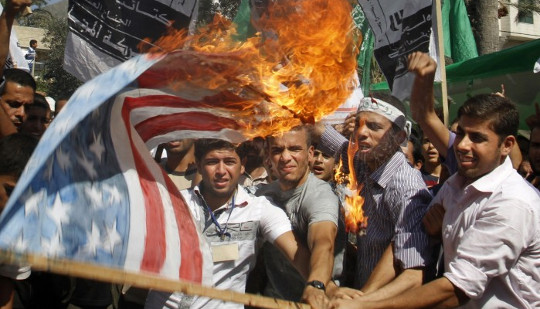
Lieutenant-General James L. Terry, commander of US forces in Iraq and Syria, recently admitted he had no idea how many civilians have died as a result of coalition airstrikes in the region.
In a briefing eerily reminiscent of the notorious “we don’t do body counts” remark by General Tommy Franks (the commander of US operations in Afghanistan and Iraq), Terry told reporters in December 2014 he was “tracking no civilian casualties” even though non-combatants are known to have been killed in at least two separate incidents.
The current failure to monitor civilians killed may seem unsurprising given the previous Bush administration’s rather glib attitude. Then-defence secretary Donald Rumsfeld was very good at deflecting criticisms of American forces. He claimed:
Responsibility for every single casualty in this war, be they innocent Afghans or innocent Americans, rests at the feet of the Taliban and al-Qaeda.
Likewise, George W. Bush argued:
Saddam Hussein regards the Iraqi people as human shields, entirely expendable when their suffering serves his purposes.
More worryingly, this attitude towards non-combatants was reflected in the kinds of operations undertaken and the types of weapons used, including cluster bombs.
The Battle For Hearts and Minds
Since 2007, however, a growing body of literature has emerged from inside the US military that stresses the importance of tracking civilian casualties on strategic rather than moral grounds.
A key component of the counterinsurgency doctrine (COIN) developed under General David Petraeus' auspices was that the US needed to move away from enemy-centric operations and embrace a more population-centric approach.
By focusing on winning the hearts and minds of ordinary people, it was argued that the insurgency’s support structure could be removed without having to confront them head-on. The overall aim is not to gain control of territory as you would in a conventional war, but to win the local population’s support by convincing them that you can protect and provide.
Within this framework, civilians' deaths become a strategic consideration rather than a purely legal one. Avoiding civilian casualties was not simply a matter of adhering to international law, but an essential part of winning the war. Sarah Sewall, a key architect of COIN, argued:
… killing the civilian is no longer just collateral damage … [it] undermines the counterinsurgent’s goals.
Lieutenant-General Curtis M. Scaparrotti also claimed:
… any civilian loss of life is detrimental to the coalition’s cause. Avoiding civilian casualties must be a top priority and it must be at the forefront of all mission planning and execution.
The US Department of the Army even put together a report focusing on ways of limiting the harm caused to civilians and the harm civilian casualties cause to the mission. One key recommendation from this report, and others, is that all non-combatant deaths should be “aggregated in a standardised database” so they can be tracked, monitored and investigated.
The rationale for this is clear. A detailed “battle damage assessment” enables the military to respond to allegations in a swift and thorough manner, mitigating the negative effects it will have on public perceptions.
Also, tracking and monitoring the deaths of civilians allows the military to identify lessons to be learnt and adjust military operations accordingly. In this respect, Terry’s recent refusal to track civilian casualties represents a radical departure from established military protocol.
A Step Backwards?
Framing civilian casualties as “strategic setbacks” is still clearly problematic. It might appear that the lives of ordinary people matter, but it is important to recognise that they only matter to the extent that they might impinge upon the success of military operations. Civilian casualties were only counted because they were considered counterproductive.
By objectifying them in this manner, the civilian population was simply co-opted into a strategic economy focused on winning the war rather than waging it more humanely. Their deaths were not mourned because they were recognised as genuine losses, but regretted because they undermined the success of military operations. Also, the idea that wars can be fought in a more humane and less violent manner has the paradoxical effect of hiding much of the pain and suffering caused.
Nevertheless, it is true that as the rules of engagement tightened and non-combatant deaths were monitored more closely, civilian casualties decreased.
In this respect, the announcement that the US is not counting the dead in the battle against IS is a step backwards. Not only does it reinforce the view that the lives of ordinary Iraqis and Syrians are not counted because they do not matter, it flies in the face of the military’s own recommendations about the strategic importance of tracking civilian casualties.
As well as being questionable on moral grounds, the refusal to count civilian casualties could be seen as a strategic mistake on the military’s own terms – fanning the flames of resentment in a region already in the midst of a violent war.
This article was originally published on The Conversation
Read the original article.
About The Authors
 Tom Gregory is a Lecturer in Politics and International Relations at University of Auckland. His research interests are in the areas of contemporary conflict, critical security studies and the ethics of war.
Tom Gregory is a Lecturer in Politics and International Relations at University of Auckland. His research interests are in the areas of contemporary conflict, critical security studies and the ethics of war.
 Alex Edney-Browne is an Honours student in Film, TV and Media Studies, and a research assistant, at the University of Auckland. Her interests include the "war on terror", drone warfare, biopolitics, technologies of intimacy, and affect theory.
Alex Edney-Browne is an Honours student in Film, TV and Media Studies, and a research assistant, at the University of Auckland. Her interests include the "war on terror", drone warfare, biopolitics, technologies of intimacy, and affect theory.























